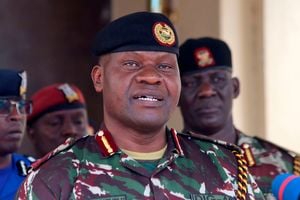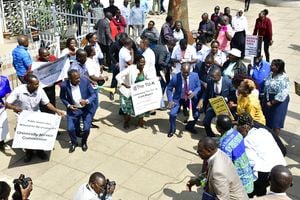Inside the G7 strategy: The path to increased political inclusion

The seven women governors. Top from left: Cecily Mbarire (Embu), Fatuma Achani (Kwale) and Gladys Wanga (Homa Bay). Bottom from left: Wavinya Ndeti (Machakos), Susan Kihika (Nakuru), Anne Waiguru (Kirinyaga) and Kawira Mwangaza (Meru).
What you need to know:
- G7 is borrowed from an informal political and economic grouping of seven advanced democracies comprising Canada, France, Germany, Italy, Japan, the UK and the US.
- The term is slowly gaining traction closer home as it has become synonymous with the seven female governors elected on August 9, 2022.
The promulgation of the 2010 Constitution heralded a new chapter for women’s leadership in the country with the creation of 47 counties as part of the new constitutional dispensation.
The new constitutional establishment saw the creation of new elective positions, including the member of county assembly, woman representative, senator and governor.
However, among the new positions, none has been able to capture the imagination of the country like the governor seat, creating ‘mini-excellencies’ at the county level.
With the country only used to male politicians hogging such hallowed titles, the governor position has catapulted women leadership into the limelight like no other.
But 13 years later, with two-thirds gender rule remaining a mirage, devolution has recorded a notable impact in terms of women’s leadership.
Female governors are now able to rub shoulders with their male counterparts at the political high table as they enjoy the privileges that come with such titles.
Enter the G7, a caucus of seven women governors. Borrowed from an informal political and economic grouping of some seven advanced democracies in the world consisting of Canada, France, Germany, Italy, Japan, the United Kingdom and the United States, the term is slowly gaining traction closer home as it has become synonymous with the seven female governors elected on August 9, 2022.
The group comprises Kirinyaga Governor Anne Waiguru, Homa Bay’s Gladys Wanga, Susan Kihika of Nakuru, Cecily Mbarire (Embu), Wavinya Ndeti (Machakos), Fatuma Achani (Kwale) and the embattled Meru Governor Kawira Mwangaza.
Governor Mwangaza is, however, currently in a battle to remain in office after the Senate upheld her removal from office by way of impeachment. She has since moved to court and obtained a stay order.
Two of members of the G7 were previously elected as women representatives (Meru and Homa Bay), one was a former senator and county assembly speaker (Nakuru). Two previously served as elected members of the National Assembly (Embu and Machakos), and one served as deputy governor for two terms (Kwale).
Before the 2022 polls, only three female politicians had ascended to the top seat in the devolved system. The honours of being pioneer female county bosses went to Charity Ngilu in Kitui, Ms Waiguru in Kirinyaga and the late Joyce Laboso in Bomet, who were all elected in 2017 polls.
Despite nearly half of registered voters in the country being women, it took about five years for the country to welcome its first female governors, laying bare how the gender gap in Kenya’s political leadership ranks remains huge, with few women making it to the list of elected leaders.
A constitutional provision introduced a “two-thirds rule” in 2010 to enable more women to get into leadership positions and tone down male dominance in politics.
Article 27(8) of Constitution provides that the State shall take legislative and other measures to implement the principle that not more than two-thirds of members of elective or appointive bodies be of the same gender.
But the forward development has barely had any effect until the 2022 elections when a rise in female governors was realised.
Former Nairobi Governor Ann Kananu is not included in the list as she became a governor in 2021, rising from a chief officer to deputy governor in quick succession, after succeeding her boss, Mike Sonko, following his impeachment.
Nonetheless, the G7 has launched an ambitious initiative aimed at giving women an equal opportunity to contest and win political seats by transforming the G7 to G16.
The strategy is meant to increase the number of elected female leaders in the next election and it involves asking the electorate to consider voting for female candidates in 2027 to enable the country to realise the two-thirds gender rule.
The need of the G7 caucus, according to the county chiefs, is to galvanise women governor’s role in leadership and to address the challenging gender barriers that hinder their progress.
They also desire to increase representation of women in politics and other leadership positions and to bring about tangible progress at all levels: national and county governments.
Further, the G7 Caucus hopes to influence Kenya’s politics using a bipartisan approach to demonstrate the advantages of gender diversity in leadership and advocate support for more women leaders in all spheres with the aim to dismantle patriarchy.
In Kenya, patriarchy, social, cultural, and religious influences have resulted in few women ascending to leadership roles with lack of economic resources a big obstacle to women’s participation in politics.
For a long time, the country has been struggling to increase the number of elected female leaders to conform to the guidelines set by the Constitution.
Ms Ngilu was the first woman in Kenya to contest for presidency in 1997, followed by Martha Karua in 2013. Currently, there are 21 female senators, 18 of whom are nominated, in the 67-member House. At the National Assembly, only 81 MPs are women, the highest number ever, out of a total of 379.
Twenty-eight female MPs were elected in 2022, up from 23 in 2017, seven female governors, up from three in 2017, and three female senators, the same number as in 2017.
However, according to the G7 strategy, they aim to crack it into the top two tiers of political influence where female political leaders can become figures with national influence and appeal.
Already, Ms Waiguru and her Homa Bay counterpart Wanga have been mentioned in several quarters as possible presidential running mates come 2027.
They are also aiming to be political party leaders and regional kingpins. Recently, Ms Wanga was appointed as ODM chairperson, replacing John Mbadi who was appointed by President William Ruto as National Treasury Cabinet Secretary. She rose to the position from the Homa Bay County ODM chairperson position.
Ms Waiguru said women governors are desirous of playing politics at the top two levels in terms of political influence and have to come together under the G7 Caucus to achieve this mission. She said the G7 members are poised to exemplify transformative women’s leadership, serving as catalysts for increased election of women in politics.
According to the Council of Governors (CoG) chairperson, the strategy is designed to safeguard against regression in women’s electoral representation, emphasising the pivotal slogan ‘G7 to G16’ as the rallying cry for elevating more women to gubernatorial positions.
She said the concerted effort aligns with the imperative of fulfilling the not more than two-thirds gender principle for the 47 county governors’ positions.
“The G7 strategy provides a framework for realising the delivery of transformative service delivery results to all Kenyans. It will act as a guide for assessing the performance and achievements for the women governors for the next four years,” Ms Waiguru said.
The strategy demands that each of the seven women-led counties will translate this strategy into a 10-year county-based blueprint, enhancing the space of women in contributing to the promise of devolution and transformative service delivery.
This will lead to the G7 creating an inclusive environment for support and learning from each other as best practice with the aim of creating more inclusive leadership, witness upward mobility by women in organisations, collective efforts by women and greater tangible progress made towards realisation of the not more than two-thirds gender principle in elective and appointive positions moving from G7 to G16.
“The G7 were concerned with how to make themselves visible and to address the invisible barriers that continue to exist in Kenya subjecting women to socio-cultural biases that deny them access to equal opportunities in economic, social and political decision-making and leadership spaces,” said Ms Waiguru.
CoG chief executive officer Mar Mwiti said the strategy is aimed at achieving gender equality and women empowerment while elevating their space for participation and representation in leadership and decision-making.
“We at the Council look forward to implementation of the strategy and will play our rightful role focusing on the low-hanging fruits,” Ms Mwiti said.
The governors are asking their male counterparts in their second and final term to consider endorsing women as their successors. Such a move has only been witnessed in Kwale, where outgoing governor at the time, Salim Mvurya, endorsed his deputy, Ms Achani, to succeed him at the helm of the Coastal county.
They also want women to be considered as deputy governors in counties where men have higher chances of winning the county top seat.
Ms Waiguru, who is the only governor to have been re-elected, said they want to ensure more women become county chiefs.
She also wants women to take other leadership positions as well, from ward to constituency level, and probably the presidency. The UDA governor explained in February this year that their intention is to support serving female governors as they seek re-election in the next poll, arguing that women work better and counties under female governors are more developed than those led by male governors.
“Devolution has played a significant role in development and we want more women as governors,” Ms Waiguru said.
“Governor Wanga is an example. Since her election, Homa Bay County has transformed significantly,” she added, in Homa Bay during the launch of the strategy in February.
As part of the strategy, the G7 will be visiting all counties to promote women’s leadership, where they will identify women with political ambitions and nurture them to be future leaders.
Ms Waiguru said the G7 seeks to enhance leadership at the county and national levels to reveal the potential of women as leaders to transform society, their gender notwithstanding.
On Friday last week, the G7 Advisory Council was unveiled in Machakos County in an event attended by former premier Raila Odinga’s wife, Ida Odinga, and Wiper leader Kalonzo Musyoka.
Milestone
She said the launch was a significant milestone on the collective journey towards gender equality and empowerment of women in leadership.
Ms Odinga challenged the governors to ensure Kenya is not left behind in terms of women’s leadership but is set on replicating the outcomes in countries like South Africa, Rwanda, Senegal, Namibia, Mozambique, Ethiopia, which have 40 per cent representation in leadership.
“The strategy isn't just a policy document, it's a blueprint for the transformative change that it will bring to generations to come. Of utmost importance is to ensure that they retain and increase the number of women in political positions among other spaces of leadership,” Ms Odinga said.
Ms Ndeti used the event to showcase a host of projects being implemented by her administration. Some of the projects that the G7 caucus visited included the Kaviani-Kathalani road in the Kathiani sub-county.
Construction of the road, which is fully funded by the Machakos government, will open up the grassroots and improve the local economy through enhanced trade and transport.
There is also the Machakos modern multi-purpose sports complex, a new city that will consist of an Olympics-size swimming pool, basketball pitch, and football pitch, as well as an athletics track. The facility, once completed, will fully nurture and commercialise the talents of young people.
The county has also opened the Machakos Gender-Based Violence Rescue Centre, a facility that will offer a safe haven for GBV survivors in terms of care services and the support they need to recover.
Ms Wanga’s focus has been on integrating technology into healthcare systems, affirmative action agenda, including funds allocation, climate change actions, emphasising women’s roles, and a governor's mentorship camp.
Projects
The governor has also prominently showcased agricultural value chains that hold significant promise, including cotton, groundnuts, sun flower, sweet potatoes, and sugar cane.
On the other hand, Ms Waiguru has showcased development projects that her administration has achieved over the years, including construction of new dispensaries, upgrading of hospitals, implementation of the Universal Health Care programme.
On Education, the county has disbursed at least Sh414 million over the years for bursary, with another Sh148 million set aside for disbursement this financial year.
The governor also set the ball rolling for early childhood education where at least 28 state-of-the-art classrooms had been constructed and equipped, with 48 others slated for renovation.
On agriculture, more than 50,000 households have benefitted from the famous Wezesha programme, with a total of Sh380 million disbursed towards projects.
The G7 is, therefore, on a path towards ensuring improved representation of women at the governor, senator, MP, MCA, and even presidential positions at the next general election.





